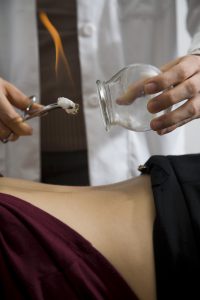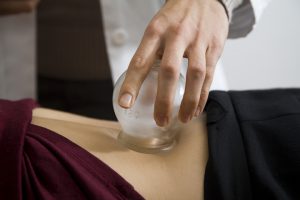“Cupping”: Traditional Therapy or Fad?
Celebrities Jennifer Aniston and Gwyneth Paltrow both boast that they receive a health therapy known as “cupping.” They’ve even gone to public events in backless gowns, showing off the odd circular bruising pattern on their backs that are temporary marks a cupping session often leaves behind.
Cupping isn’t some weird new Hollywood trend reserved for movie stars, it is actually a traditional healing art in the field of oriental medicine. It’s been used in China for thousands of years, from the Qing dynasty onward.
 During a cupping treatment, glass cups that look like miniature fish bowls are heated inside to produce a vacuum. The heated cups are then placed open-ended on the surface of the patient’s skin. The suction forces the cup to adhere to the skin, gently pulling the body’s surface tissue up into the cup. This prolonged suction is what provides the therapeutic effect, and the odd circular bruising afterwards.
During a cupping treatment, glass cups that look like miniature fish bowls are heated inside to produce a vacuum. The heated cups are then placed open-ended on the surface of the patient’s skin. The suction forces the cup to adhere to the skin, gently pulling the body’s surface tissue up into the cup. This prolonged suction is what provides the therapeutic effect, and the odd circular bruising afterwards.
Cupping is actually very comfortable, and once a patient receives the treatment, they often request it each time they come in. Because it reduces muscular tension, it works well on conditions where there is muscular pain or achiness.
However, since the clinician can apply the technique to key acupuncture points, it can be therapeutic for almost any health condition if done by a properly trained practitioner. This can include digestive problems, blood pressure issues, skin conditions and more.
Cupping even has cosmetic applications. It is sometimes used as a therapy to treat cellulite or unsightly vein problems.
 Different sizes of cups are used to treat different areas of the body, and to create different levels of suction. New plastic cups can create suction through a hand pump instead of heat.
Different sizes of cups are used to treat different areas of the body, and to create different levels of suction. New plastic cups can create suction through a hand pump instead of heat.
While cupping is generally considered very safe, there are certain conditions where cupping should not be used. Cupping is not advised for any patient taking blood thinning medication, or who has a sunburn, wound, skin ulcer, or recent trauma. Cupping should also not be performed on children under age four, and only for five minutes on children up to the age of seven and ten minutes on children from ages seven through fourteen. There are also certain areas, such as the lower abdomen, lower back and certain acupuncture points, that should not be cupped on pregnant women.
And be warned! Cupping will leave slight bruising. Patients are often well advised about this by their practitioner so that they aren’t surprised or scared when it happens.
Cupping is part of the NUHS required curriculum for masters degree students in acupuncture and oriental medicine.
At the NUHS Whole Health Center, patients receive a comprehensive oriental medicine diagnosis and treatment plan based on their unique health history. Depending on the patient’s diagnosis, cupping may be part of a treatment plan, which can also include acupuncture, herbal medicine, dietary therapy or other natural approaches.
So while Hollywood may report cupping as the latest modern fad, the stars are really falling back on a time tested ancient healing art.
If you would like to consult with an acupuncture and oriental medicine clinician on whether cupping or oriental medicine may help with your health concerns, call the NUHS Whole Health Center-Lombard at 630-629-9664 to schedule an appointment.

